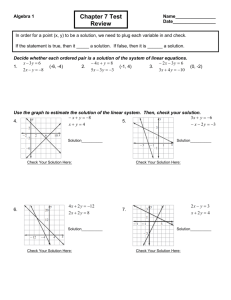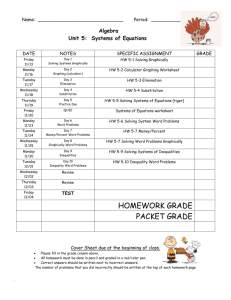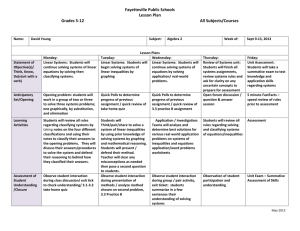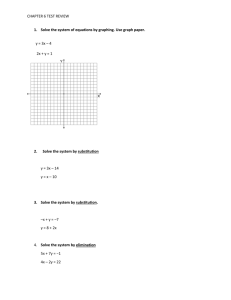Pre-Calculus
advertisement
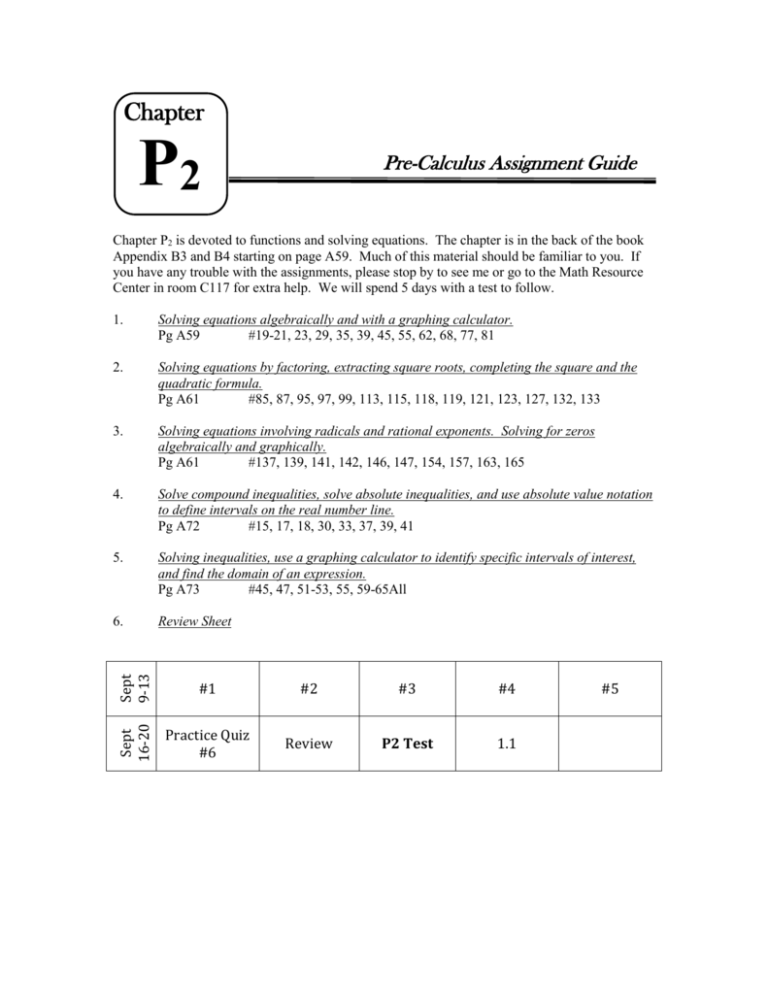
Chapter P2 Pre-Calculus Assignment Guide Chapter P2 is devoted to functions and solving equations. The chapter is in the back of the book Appendix B3 and B4 starting on page A59. Much of this material should be familiar to you. If you have any trouble with the assignments, please stop by to see me or go to the Math Resource Center in room C117 for extra help. We will spend 5 days with a test to follow. 2. Solving equations by factoring, extracting square roots, completing the square and the quadratic formula. Pg A61 #85, 87, 95, 97, 99, 113, 115, 118, 119, 121, 123, 127, 132, 133 3. Solving equations involving radicals and rational exponents. Solving for zeros algebraically and graphically. Pg A61 #137, 139, 141, 142, 146, 147, 154, 157, 163, 165 4. Solve compound inequalities, solve absolute inequalities, and use absolute value notation to define intervals on the real number line. Pg A72 #15, 17, 18, 30, 33, 37, 39, 41 5. Solving inequalities, use a graphing calculator to identify specific intervals of interest, and find the domain of an expression. Pg A73 #45, 47, 51-53, 55, 59-65All 6. Review Sheet Sept 9-13 Solving equations algebraically and with a graphing calculator. Pg A59 #19-21, 23, 29, 35, 39, 45, 55, 62, 68, 77, 81 #1 #2 #3 #4 Sept 16-20 1. Practice Quiz #6 Review P2 Test 1.1 #5 Even Answers to Chapter P2 Pg A59: 1 20. 2 1 62. 5 68. 10 Section 2 Pg A61: 118. 0, -3 3 132. , 2 5 Section 3 Pg A61: 142. 36 3 5 154. 10, -1 146. 0, 1, Section 4 Pg A72: 18. [ -3, 7 ) 30. x 24 , x 16 Section 5 Pg A73: 52. a. b. (,4] [1,4] (2] [5, ] 60. x 5 2 62. ( , ) 64. [2, 2] H-Pre-Calculus Chapter P2 Review 2x 6 1 x 4 2. Solve: x 2 3x 4 x 6 4. Solve: 2 x 5 15 x 3 27 x 0 1. Solve: 3. Solve: t 2 7t 1 12 0 5. Solve by completing the square: 6. Solve: 7. Use a graphing calculator to find the x & y intercepts of y x 2 4 8. Use a graphing calculator to find the x & y intercepts of x 2 y x 2 4 y 0 9. 10. 2 x 2 4 x 12 0 3 4 5 x2 x2 y 4 x2 Use a graphing calculator to find the intersection point(s) of y 2x 1 3 2 Solve: x x 9 x 9 0 2 11. x x Solve: 6 5 10 x 1 x 1 12. Solve: 4 xx 13 2x 1 3 0 13. Solve: 7 14. Given the graph of f(x), where is f(x) > 0. 15. Solve: x 5 1 16. Solve: 3x 2 4 17. Use a graphing calculator to approximate the values of x that satisfy the specific inequalities: y x 3 4x 2 2x 3 a. y<0 b. y>5 18. Solve: 1 40 x 19. Solve: x 12 5 x2 1 4 4x 5 19 5 2 H-Pre-Calculus Chapter P2 Targets Major Objective: Solve polynomial equations, radical and rational exponent equations, compound and absolute value inequalities, and determine their domain. P2.1 Solve a variety of equations from Algebra II. 1. I can solve rational equations. a. 1 3 6x 2 x2 x2 x 4 c. 2 3 6 = 2 x - 10 x -2 x - 12x + 20 e. 3 4 5 x2 x2 2 x2 - 5 6 4x -7 b. + = 2 x+ 2 x -2 x -4 2 10 x + x - 2 4x 2x - 3 d. = + 2 2 x - 9x -18 x -6 2x + 3 f. 13x +16 8 x2 +12x +14 24x - 8 + = 2 4x -1 4 x +11x - 3 x+ 3 2. I can solve for x & y intercepts algebraically and with a graphing calculator a. 2x + 3y = 5 b. y x 2 4 c. y x 2 5 x 11 3. I can solve for solutions of a polynomial equation by finding zeroes with a graphing calculator a. x 2 3 5x b. x 2 y x 2 4 y 0 4. I can find the point of intersections of two graphs with a graphing calculator y x 2 3x 4 a. 3 2 y x 3x 2 x 1 P2.2 y 4 x2 b. y 2x 1 Solve equations with polynomials. 5. I can solve equations by factoring and using the zero product property a. 2x3 6x 2 6x 18 0 b. 2 x 5 15 x 3 27 x 0 c. x 3 x 2 9 x 9 0 6. I can solve equations by extracting square roots. a. c. b. 7. I can solve equations by completing the square a. x2 + 6x = 5 c. 2x2 – 4x – 12 = 0 b. 3x2 – 8x – 5 = 0 8. I can solve equations by using the quadratic formula a. 2x2 + 3x – 1 = 0 c. 3 4 x2 2 5 x40 b. 7x2 – 6x – 9 = 0 d. 5 3 x2 3 4 x 2 3 0 P2.3 Solve equations with radicals or rational exponents and finding zeroes. 9. I can solve equations by substitution a. Solve 6x 7 x 3 0 b. t 2 7t 1 12 0 2 x x c. 6 5 1 0 x 1 x 1 10. I can solve equations with one or more radicals b. 5 x x 7 11 a. c. 3x 3 15 0 d. 5 3 2 x 6 0 e. x 10 x 6 8 f. x2 7 x9 11. I can solve equations with common factors that are raised to rational exponents a. x c. x2 x2 1 2 1 2 3 x2 1 12 0 b. 4 xx 13 2x 1 3 0 0 d. 1 x 0 f. 22 x 2 1 x 2 x 5 3 x2 1 e. 3 x 2 x x 2 13 43 1 2 1 3 1 3 4 x3 1 x3 1 23 0 32 12. I can solve equations with absolute values a. P2.4 x 2 3x 4 x 6 Solve compound and absolute value inequalities. 13. I can solve inequalities a. 1 3 x x4 2 b. 3x 2 8 x 4 12 x 5 14. I can solve absolute value inequalities a. x 5 2 b. | 2x + 5 | > 9 c. 3| 9 – 4x | < 11 d. -5| 3x + 4 | > 7 e. 12 < | 3x – 5 | < 25 f. 36 3 23 x 5 21 15. I can use absolute value notation to define intervals on a number line. a. P2.5 b. -2 6 Solve polynomial inequalities and find domain. 4 12 16. I can solve polynomial inequalities algebraically by setting up test intervals x 5 2 1 a. 2x3 3x 2 32x 48 b. c. 3x 2 4 =0 17. Find intervals of satisfaction for inequalities with a graphing calculator a. Use interval notation to find where 6x3 21x 2 15x 12 0 b. Use interval notation to find where 2x4 - 9x2 + 7 > 2 c. Given the graph of f(x) at the right, where is f(x) > 0. d. Use a graphing calculator to approximate the values of x that satisfy the specific inequalities: y<0 y x 3 4x 2 2x 3 e. Use a graphing calculator to approximate the values of x that satisfy the specific inequalities: y>5 y x 3 4x 2 2x 3 18. I can solve rational inequalities graphically with a graphing calculator 2 - x6 6 2x 7 a. b. x c. 4 3 0 x 5 x-2 x -1 x 1 2 3 3 d. e. x-3 x6 x3 19. I can find the domain of an expression or equation 3 a. b. y x 5 5 y 3 2x 5 c. y d. 3x 2 20. I can apply the above concepts to a variety of applications. a. The metabolic rate of an organism increases with increasing temperature with a certain range. Experimental data for oxygen consumption C (in microliters per gram hour) of an insect at certain temperatures yielded the model C = 0.43x2 – 1.75x + 53.25, 15 < x < 30, where x is the air temperature in degrees Celsius. i. Use a graphing calculator to graph the consumption model over the specified domain. ii. Use the graph to approximate the air temperature resulting in oxygen consumption of 160 microliters per gram per hour. iii. The temperature is increased from 15oC to 25oC. The oxygen consumption is increased by approximately what factor? b. The total number y of electric-powered vehicles in the United States from 1992 to 2001 can be approximated by the model y 75.76t 2 912, 2 t 11 where t represents the year, with t = 2 corresponding to 1992. i. Determine algebraically when the number of electric-powered vehicles reached 7000. ii. Verify your answer in part (i) by creating a table of values for the model. iii. Use a graphing utility to grapy the model. iv. Use the zoom and trace features of the graphing calculator to find the year in which the total number of electric-powered vehicles reached 9000. v. Verify your answer in part (iv) algebraically.


